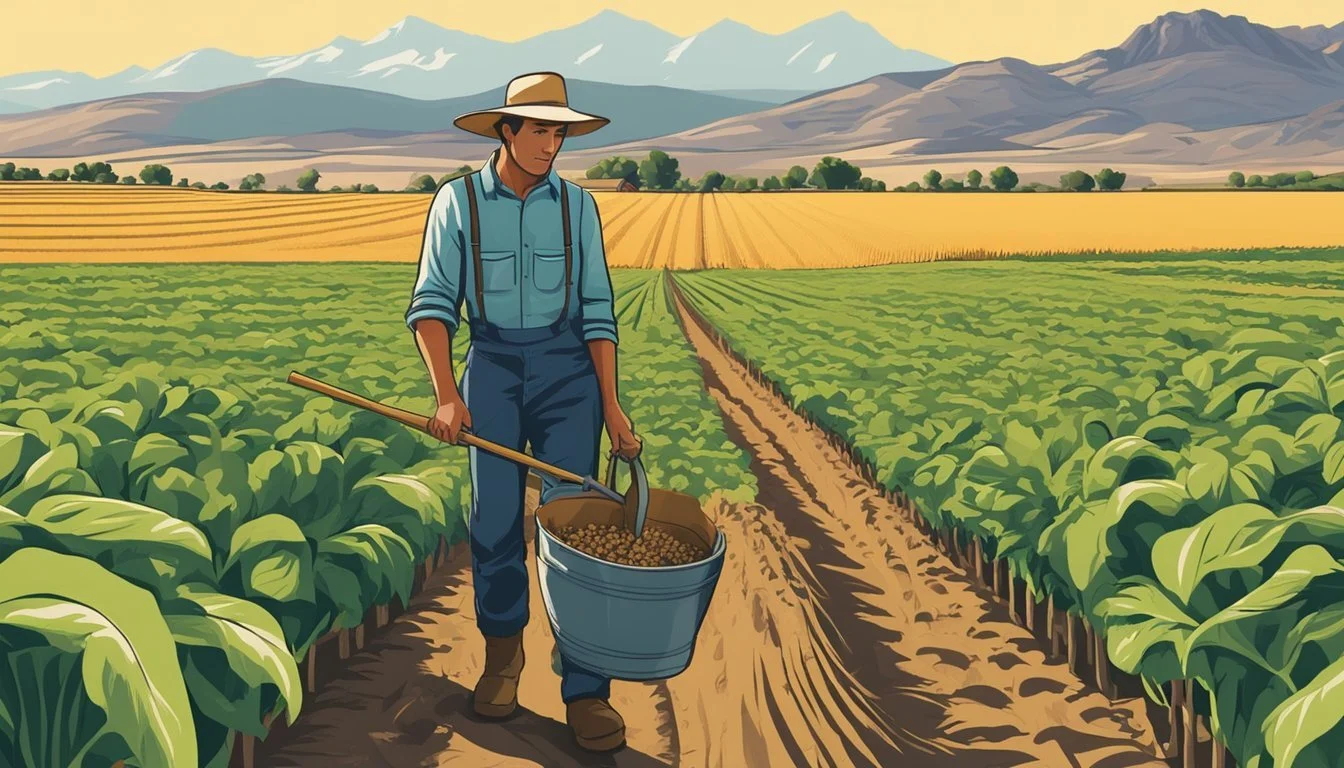Right to Farm Law in Utah
Understanding Agricultural Protections
The Right to Farm Law in Utah serves as a legislative shield for agricultural operations against nuisance lawsuits. This set of statutes, entrenched in the Utah Code, particularly sections 17-41-401 to 17-41-406, affirms the significance of farming and ranching to the state's economy and way of life. Aimed at preserving agricultural land, these laws ensure that farming practices are protected, thereby providing stability to farmers and farm operations that might otherwise be threatened by urban encroachment and the complaints that sometimes follow.
Utah's agricultural sector has evolved since the enactment of Right to Farm statutes between 1994 and 1995, showing notable growth in the number of farm operations despite a decrease in the land dedicated to farming. These statutes have become critical in maintaining the viability of farming in the state, acknowledging that agriculture is an essential, although sometimes disruptive, part of Utah's heritage and economy.
However, the dynamics of Right to Farm laws are multifaceted and have sparked discussions on their broad implications. While proponents argue that such laws are vital for defending the interests of farmers against unfair legal challenges, others raise concerns about the potential adverse effects on neighboring properties and local communities. The ongoing conversation reflects the delicate balance Utah seeks to strike between fostering a robust agricultural sector and addressing the interests of its diverse population.
History and Background
Utah's right-to-farm laws have evolved to balance agricultural preservation with the growth of urban areas. This section explores the progression of these laws, their comparison with statutes in other states, and pivotal legal cases that have shaped their enforcement and understanding.
Evolution of Right to Farm Laws
Utah legislatures first introduced right-to-farm laws as a strategic measure to protect agricultural lands and operations from nuisance lawsuits. These laws have subsequently expanded, with key updates happening between 1994 and 1995. In response to urban expansion and potential conflicts between new residents and existing farming operations, these laws evolved to offer greater security for farmers. They serve as a shield, enabling farms to operate despite the pressures of urban encroachment. Over time, Utah's additional RTF-related statutes have led to a noticeable 19 percent growth in the number of farm operations, though there has been a decline in the state's land in farms by over 6 percent.
Comparison With Other States
Right-to-farm laws are not unique to Utah and exist in various forms throughout the United States. States such as North Carolina, Georgia, West Virginia, and Kansas have their own versions of these statutes. Each state's laws are crafted to address the specific needs and concerns faced by their agricultural communities. The National Agricultural Law Center provides a comprehensive comparison of these statutes, highlighting differences and similarities across states. Utah's statutes, codified as Utah Code Ann. §§ 17-41-401 to 17-41-406, emphasize the protection of agricultural land by mitigating the potential effects of non-agricultural land development.
Key Legal Cases
The implementation and interpretation of right-to-farm laws have been shaped by various legal cases over the years. In Utah, as well as nationwide, these cases typically surface due to conflicts between agricultural practices and non-farming neighbors. A prominent legal case in Utah or any mentionable case that served as a precedent in shaping the state's right-to-farm statutes illustrates the practical application of these laws within judicial proceedings. Compared to other states, unique legal challenges may arise, but fundamental underpinnings of right-to-farm provisions remain similar: to uphold the interests of farmers against nuisance claims and urban expansion.
Current Legal Framework
The current legal framework for Right to Farm laws in Utah is designed to safeguard farming operations through specific statutory language, by defining the scope of protected farming activities and setting forth certain limitations and restrictions in accordance with state law.
Statutory Language in Utah
The Utah Code Ann. §§ 17-41-401 to 17-41-406 embodies the state's Right to Farm law. It reflects a legislative intent to protect legitimate agricultural operations against nuisance lawsuits and other adverse legal actions. As such, the statutes affirm the value of agricultural activities to the economic and social welfare of the state.
Protected Farming Operations
Under Utah state law, farming operations are granted certain protections aimed at maintaining the viability of agricultural land and the farming industry. These protections apply to a variety of farming activities encompassing the production of crops, livestock, poultry, and related products. Farming operations, as long as they comply with federal and local laws and operate in a manner consistent with proper agricultural practices, are shielded against nuisance claims.
Limitations and Restrictions
Utah's Right to Farm statutes do not offer blanket immunity for agricultural practices. They detail specific limitations and restrictions to ensure that the statutes are not misused:
Statutory Schemes: The statutes are structured to prevent conflicts with existing federal and local laws.
Provisions: The laws contain provisions that may exclude certain operations from protections if they have a substantial adverse effect on public health and safety or if they do not follow appropriate agricultural practices.
Changes in Operation: Changes in the nature of the operation may also affect the degree of protection afforded under the statutes.
By establishing a balance between the needs of agricultural producers and the broader community interests, the statutory framework supports both the farming industry and environmental stewardship.
Nuisance Claims and Litigation
In Utah, nuisance laws intersect significantly with agricultural practices, affecting how lawsuits are navigated and resolved. This section delves into how nuisance claims arise in the context of farming, the parties typically involved, and the nature of litigation, including specific cases and the types of damages awarded.
Typical Plaintiffs and Defendants
Plaintiffs in nuisance lawsuits are often neighbors or community members who allege that a farming operation negatively affects their property or quality of life. Defendants are typically farmers or agricultural entities that are protected under Utah's Right to Farm laws. These laws serve to shield agricultural operations from nuisance claims, provided that the farming activities are lawful and consistent.
Nuisance Lawsuits Against Farmers
A nuisance lawsuit against a farmer may allege that the farmer's operation creates smells, noise, or other conditions that interfere with the plaintiff's use and enjoyment of their property. However, in Utah, Right to Farm statutes offer robust protections to farmers by limiting the circumstances under which they can be liable for nuisance claims. These laws affirm that if a farm complies with existing regulations and has been established for a certain period, nuisance lawsuits have less ground to stand on.
Case Studies: Smithfield and Others
Smithfield, a well-known agriculture company, has faced various lawsuits across the United States. In other states, juries have sometimes awarded large compensatory and punitive damages for nuisance claims against Smithfield. However, in Utah, the Right to Farm laws would likely influence how these cases are judged, potentially reducing the liability of agricultural entities like Smithfield and emphasizing the importance of context in nuisance litigation.
Punitive and Compensatory Damages
Damages in nuisance cases can be categorized into two types:
Compensatory Damages: Monetary awards intended to compensate the plaintiff for actual harm or loss suffered.
Punitive Damages: Sums that may be awarded to punish the defendant for particularly egregious conduct and to deter others from similar acts.
In the context of Utah's Right to Farm laws, such damages against farmers would likely be limited, as the laws are meant to protect agricultural operations from the burden of excessive litigation and encourage farming continuity.
Impact on Farming Practices
The Right-to-Farm Law in Utah is designed to support agricultural endeavors by protecting farming operations and encouraging certain advancements. This impacts farming practices by bolstering innovation and safeguarding livestock operations, which in turn has repercussions on property values surrounding agricultural areas.
Farming Innovations and Adaptations
In response to the Right-to-Farm Law, Utah's farmers have been implementing various innovations and adaptations to enhance productivity and sustainability. These actions range from introducing water-efficient irrigation methods to adopting soil health practices that reduce erosion and improve crop yields. Technologies such as precision agriculture have gained attention, allowing farmers to optimize inputs and reduce environmental impacts.
Effects on Livestock and Poultry Operations
The law provides livestock and poultry operations with certain protections, enabling ranchers to employ contemporary animal husbandry methods without undue restrictions. As a result, producers can focus on improving the quality of life for their animals through better housing, nutrition, and health management practices that comply with industry standards, thereby potentially enhancing productivity and welfare.
Influence on Property Values
Right-to-Farm statutes have a nuanced effect on local property values. While they can lead to increased investment in agriculture, safeguarding the interests of farmers and ranchers, the presence of large farming operations might lead to mixed reactions among residential property owners due to concerns about odors, noise, and traffic. However, these laws also maintain the rural character of the land, which can be an asset in attracting certain buyers looking for pastoral settings or interested in agri-related business opportunities.
Social and Environmental Considerations
The Right to Farm Law in Utah is pivotal in shaping the interactions between agricultural practices and the broader social and environmental landscapes. Key social issues include the dynamics between farming operations and rural community relations, while environmental concerns center on the impacts of modern agriculture on ecosystems and public health.
Community Relations and Rural Areas
Maintaining robust community relations is essential for farm operations within rural areas. As agricultural activities expand due to protections afforded by Right to Farm laws, rural residents often experience changes in quality of life due to factors such as noise, smell, and increased traffic from farm operations. These issues can lead to divisions between newer residents and established farmers who benefit from the law's protections.
Environmental Implications of Modern Farming
Under Right to Farm statutes, the environmental implications of modern farming must be scrutinized. Intensive practices can lead to:
Increased air emissions impacting overall air quality
Potential water pollution, which organizations like the Waterkeeper Alliance monitor closely
The alteration of landscapes that may lead to environmental fallout These issues are particularly pronounced near large-scale operations, which may affect both ecosystems and residential areas.
Public Health Concerns
Farming practices have direct ties to public health concerns. Emissions from livestock and crop production can contribute to air and water quality issues, which in turn can affect the health of local populations. Sensitive groups, such as low-income people of color, may face greater risks of exposure to pollution from agricultural activities, and therefore, the implementation of Right to Farm laws requires a balanced approach to protect these vulnerable communities.
Opposition and Support
In the debate over Utah's Right to Farm laws, there are distinct factions on either side, with advocacy groups and agricultural lobbyists championing the legislation, while rural communities and urban perspectives show a mix of support and opposition.
Advocacy Groups and Agricultural Lobbyists
Agricultural lobbyists and advocacy groups such as the Utah Farm Bureau staunchly support Right to Farm laws. They argue that such legislation is essential to safeguard farming operations from nuisance lawsuits and secure the agricultural industry's future. These entities emphasize the importance of the Right to Farm as a way to preserve farmland and protect farmers from legal challenges that could threaten their livelihood.
Key Proponents:
Agricultural Lobby Groups
Farm Bureau
Rural Communities and Urban Perspectives
Among rural communities, there is generally strong support for Right to Farm legislation, as it is seen as vital for maintaining the agricultural way of life. However, some rural residents express concern over potential environmental and nuisance issues that may not be addressed sufficiently due to the protections offered to farmers under these laws.
Urban perspectives are often more varied, with entities like the American Society for the Prevention of Cruelty to Animals (ASPCA) expressing opposition to the legislation. The ASPCA contends that some Right to Farm laws may undermine efforts to prevent animal cruelty by limiting regulations and shielding certain farming practices from scrutiny.
Concerns Raised:
Environmental impact
Nuisance issues
Animal welfare standards
Future of Right to Farm Legislation
The future of Right to Farm laws in Utah is likely to evolve as legal challenges emerge and potential reforms are discussed.
Ongoing Legal Developments
Legal challenges continue to shape the Right to Farm laws. With a trend of increased litigation, the Utah legislature may see the need to update these statutes to clarify the protections offered to farmers and to address the concerns of urbanizing areas. Researchers observe these legal developments closely, often using resources like the National Agricultural Law Center to track changes in the legal landscape. This information could be displayed in a chart or a map, offering a visual representation of how Right to Farm laws are being tested and modified across the state.
Potential Reforms and Trends
As the agricultural sector evolves, so too might the legislation that governs it. Potential reforms in Utah's Right to Farm Law could include:
Enhanced Protections: Strengthened provisions to shield farmers from nuisance lawsuits, potentially influenced by research publications on comparative law practices.
Balanced Interests: Changes that seek a balance between farm operations and non-farming neighbors' rights.
Agricultural Sustainability: Incentives or requirements to promote sustainable farming practices.
Lawmakers and stakeholders will likely look to recent legislative trends and consult with legal experts to navigate these changes. The outcome will not only affect farmers but also the broader community that interacts with and relies upon Utah’s agricultural industry.
Additional Resources
The pursuit of knowledge in agricultural law is essential for understanding and navigating the nuances of the Right to Farm laws in Utah. These resources offer comprehensive insights through legal analyses and provide interactive tools for a nuanced grasp of the statutes in place.
Research Publications and Analysis
National Agricultural Law Center: An indispensable resource offering a trove of research publications.
Topics Included: Analysis of Right to Farm statutes, legislative changes, and their impacts on the agricultural landscape.
One Rural: Articles summarizing legislative motives and historical data on farming trends post-legislation.
Articles Highlighted: Insights into the practical effects of Right to Farm laws in Utah.
Legal Tools and Charting Mechanisms
Utah State Legislature: Essential for legal documentation and updates.
Tools Available: Texts of bills such as HB0031S03, outlining agritourism and agriculture enterprise definitions.
American Farmland Trust: Provides resources for farmers and stakeholders to stay informed.
Mechanisms Offered: Updates and information pertinent to farming practices and legislation mailed directly to subscribers.









